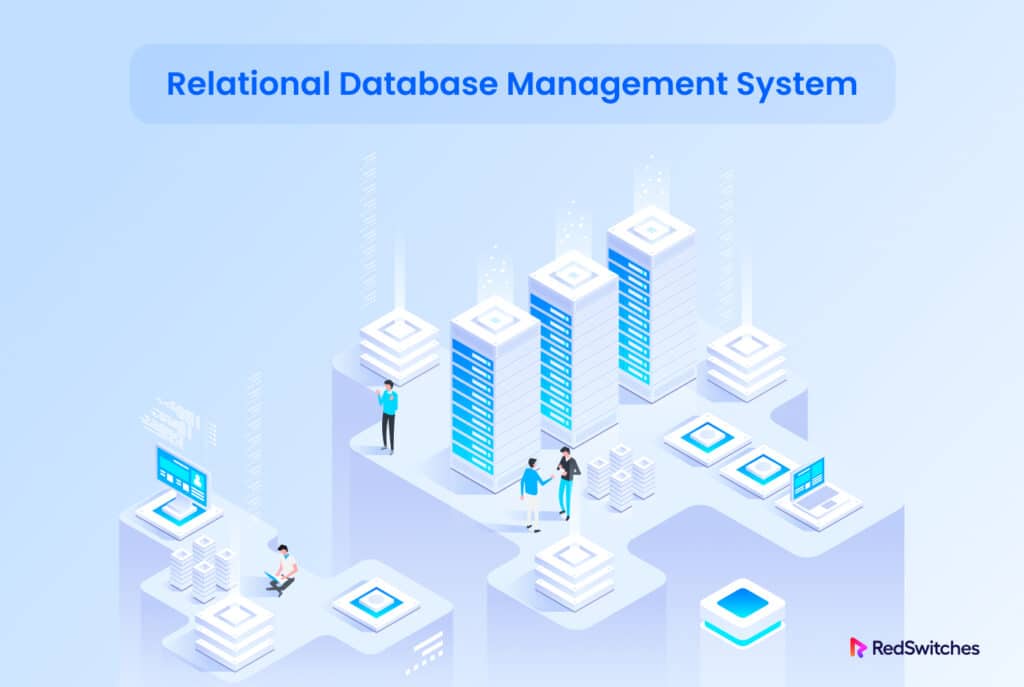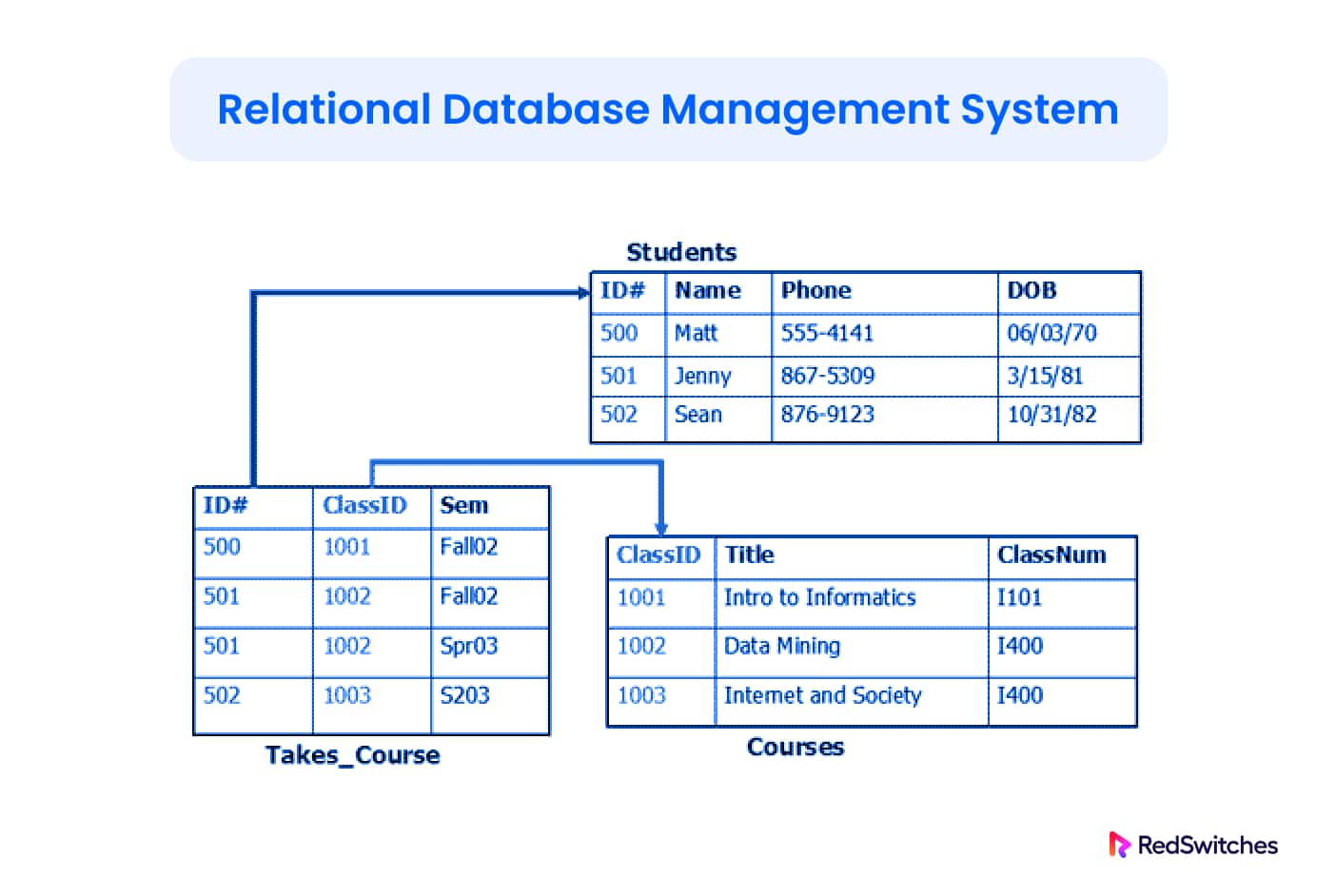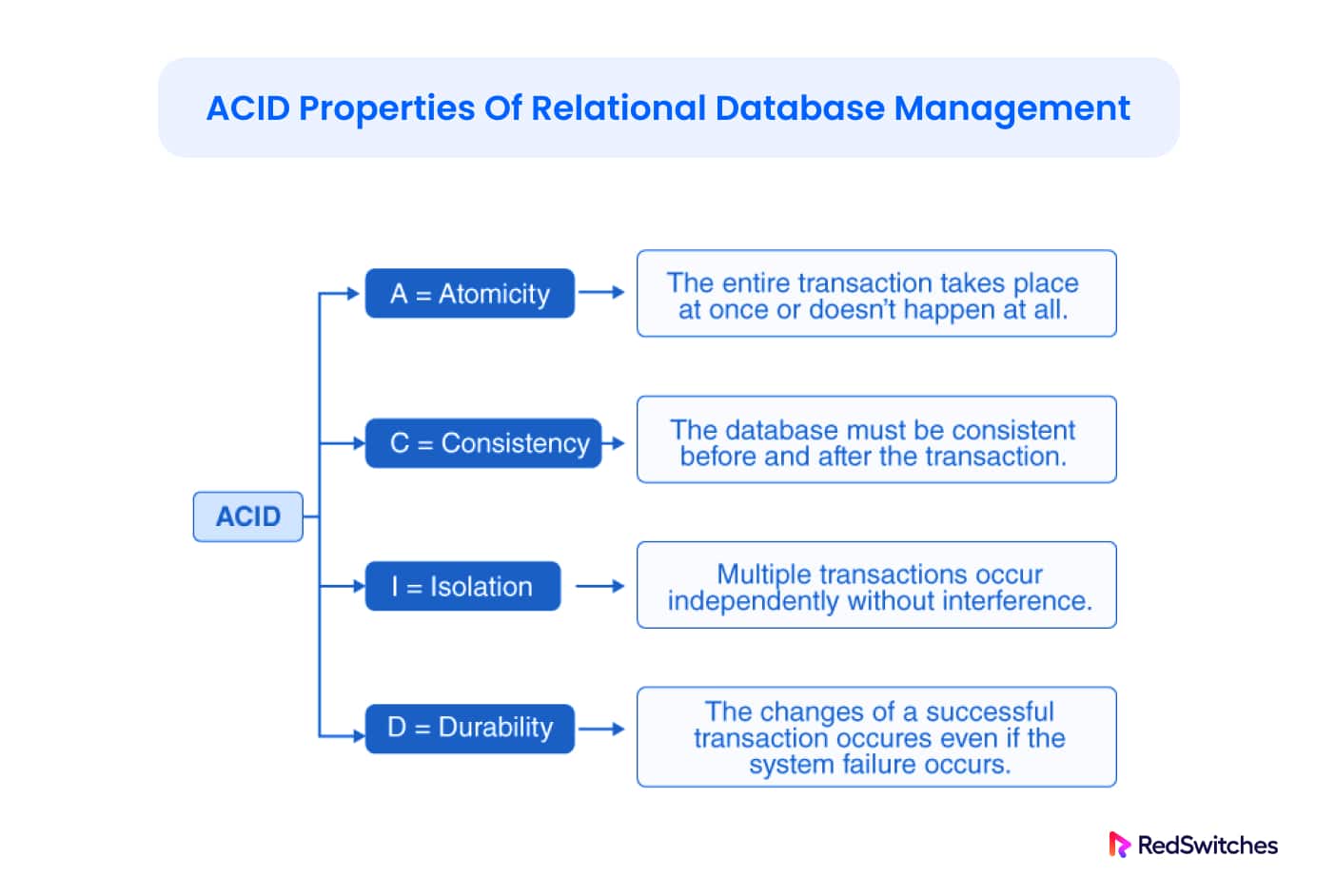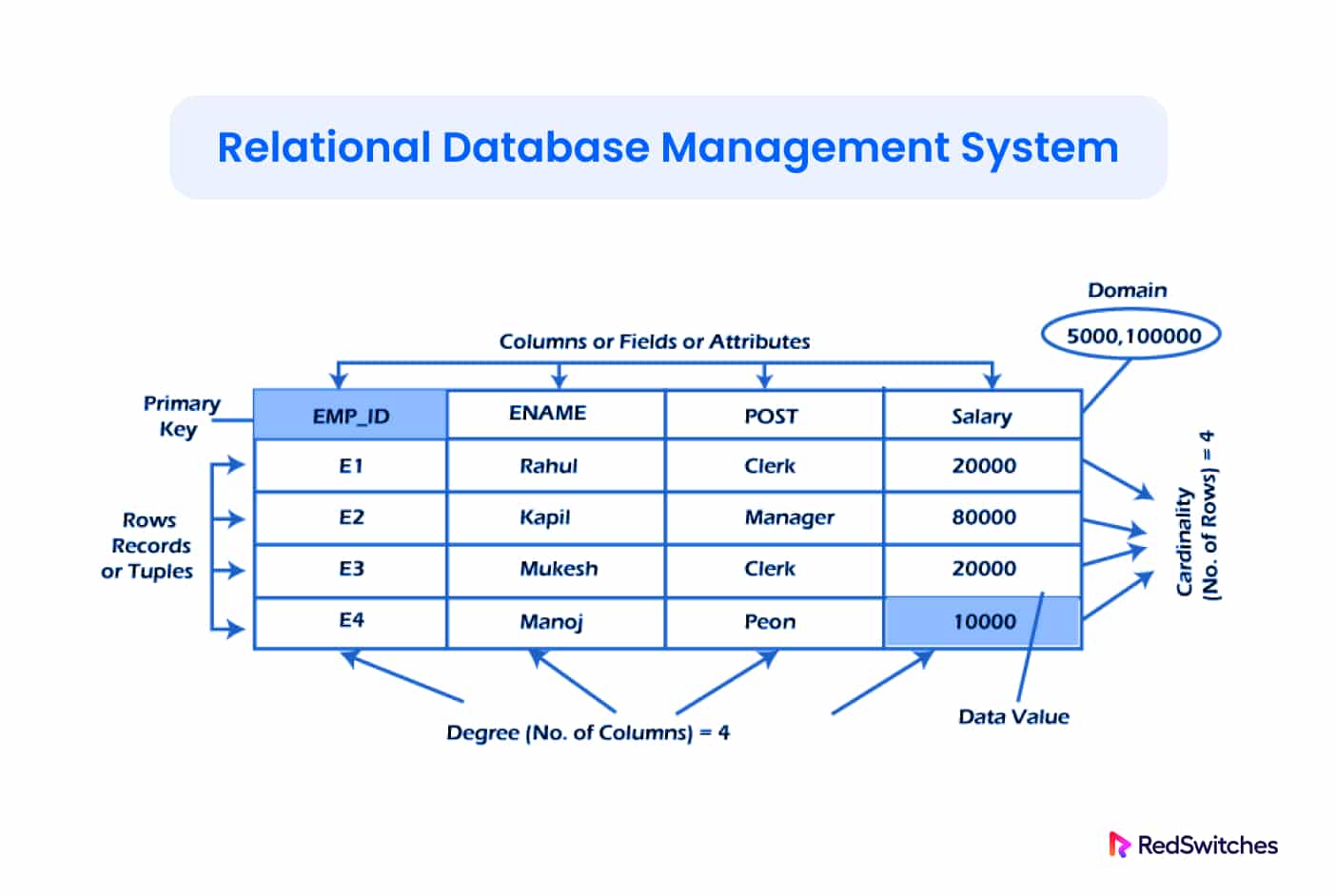Databases are an essential application component for storing, organizing, and retrieving data. Relational database management systems have become the backbone of modern data management, revolutionizing how businesses handle and analyze information.
A Relational Database Management System (RDBMS) comprises software tools empowering IT teams and individuals to design, modify, and interact with relational databases effectively. The RDBMS stores data in the form of tables and is the most popular database system used at a global scale. These database systems can reliably store large volumes of data and support fast data read and write actions for the applications.
Whether you are a business owner, a data analyst, or an IT professional, solid knowledge of RDBMS can significantly enhance your ability to store, manage, and utilize data effectively.
This article will explore the key concepts and benefits of relational Database management Systems and their comparison with traditional DBMS.
Table Of Contents
- What is an RDBMS?
- The Key Concepts of RDBMS
- How Does an RDBMS Work?
- Advantages of RDBMS
- The Major Differences Between RDBMS and DBMS
- RDBMS Use Cases
- Some Popular RDBMS
- Conclusion
- FAQs
We’ll start with a short discussion about what is an RDBMS.
What is an RDBMS?
An RDBMS is a DBMS that stores data in a row-based table structure that links relevant data items.
The idea behind using an RDBMS is to preserve the data’s consistency, accuracy, integrity, and security. The relational data model, created by E.F. Codd in the 1970s, is the foundation of the RDBMS.
The RDBMS stores data in tables, with rows and columns in each table. The columns, also known as vertical entities, carry information about certain fields, whereas the rows, also known as records or horizontal entities, include information for individual entries.
The RDBMS uses sophisticated algorithms to enable several concurrent users to access the database and carry out data storage or retrieval without causing conflicts in data.
The Key Concepts of RDBMS
The idea of an RDBMS is a composite of the following five concepts.
Tables
Tables are the fundamental building blocks of an RDBMS.
Every table has a distinct primary key that is used to distinguish a specific record in a database. A record in one table may be related to another record in another table (1:1), a record in one table may be related to several records in other tables (1:M relationship), and multiple table records may be linked to numerous records in another table (M: N relationship).
Data Organization
An RDBMS organizes data in tables that can be linked internally via secondary and foreign keys. This lets users easily retrieve one or more tables with just one query. The RDBMS structures data in such a way that ensures consistency and integrity while being easily scalable for growing data volumes.
SQL Interface
Structured Query Language (SQL) is the main language used to access the database in an RDBMS. Database designers and admins can use SQL statements to define and manipulate data and the database’s structure.
SQL is a very popular option for working with an RDBMS, and all mainstream programming languages have native or extension-based support for SQL queries.
ACID Compliance
RDBMSes use the ACID model (Atomicity, Consistency, Isolation, and Durability) to maintain consistency across the database.
The relational technology feature associated with ACID compliance has proven crucial in business computing. These features have made RDBMSes especially well-suited for managing business transactions in a multi-user environment.
CRUD Operations
The CRUD (create, read, update, and delete) operations are the most fundamental RDBMS operations. RDBMS uses CRUD activities to handle data in the tables via a uniform interface that developers can access and manage through code.
How Does an RDBMS Work?
As previously mentioned, in an RDBMS, data is organized into tables, each with its unique primary key for identification purposes.
These tables consist of rows and columns. Rows, also known as records or horizontal entities, contain information for individual entries, while columns, referred to as vertical entities, hold specific field data.
The RDBMS checks the following constraints before it authorizes creating a new table.
Primary keys: A distinct primary key is used to distinguish the rows in each table. There can only be one primary key per table, which must be distinct and not null.
Foreign keys: Two tables are connected by foreign keys. One table’s foreign key can refer to another table’s primary key, creating a direct relationship between the two.
Not Null: This check ensures no column is empty or has a NULL value.
Logical Checks: These checks ensure data uniqueness by confirming that each entry in a column or row satisfies specific conditions.
Data integrity: This is a critical requirement before data creation and involves several specific tests.
Entity integrity: Ensures that rows are not duplicated in the table to preserve data uniqueness.
Domain integrity: Verifies that data entered into the table meets specific conditions, such as adhering to file formats or falling within defined value ranges.
Referential integrity: Guarantees that a row linked to another table cannot be deleted. This is an essential operational constraint to prevent orphaned records.
User-defined integrity: Verifies that the table complies with all user-defined conditions. The database designers define these checks to conform the data to the broader utilization requirements at the application level.
By adhering to these constraints and integrity checks, an RDBMS maintains the organization, accuracy, and reliability of the stored data.
Advantages of RDBMS
Using an RDBMS offers numerous benefits to organizations, facilitating a systematic approach to raw data and empowering companies to gain deeper insights and improve decision-making. Storing data in tables enhances information security, enabling users to customize access levels and set restrictions. This makes it particularly valuable for companies where managers control data access for employees and customers.
Moreover, RDBMS systems simplify adding new data or modifying existing tables while ensuring consistency with the existing content.
Additional advantages of using RDBMS include
Flexibility: Updating data becomes more efficient as changes need only be made in one place, ensuring data coherence throughout the database.
Maintenance: Database administrators can easily manage, control, and update data, while automation tools integrated into the RDBMS streamline tasks such as backups.
Data structure: The tabular format employed by RDBMS is intuitive and provides a well-organized structure for matching entries through query operations.
The Major Differences Between RDBMS and DBMS
Let’s look at the main differences between RDBMS and DBMS.
|
DBMS |
RDBMS |
|
|
|
|
|
|
|
|
|
|
|
|
|
|
RDBMS Use Cases
Relational Database Management Systems are crucial to a wide range of industries due to their ability to handle large amounts of data and meet complex business requirements. The following are some common use cases of using RDBMS across different sectors.
-
Banking Industry
An RDBMS is critical in managing vast data volumes in the banking sector, including customer information, account details, transaction records, and loan information. AN RDBMS is a top choice in this industry because it offers security, accuracy, and transactional integrity.
-
eCommerce Platforms
eCommerce platforms need a robust solution for managing a wide range of data, such as customer data, purchase histories, product statistics, and inventory details. An RDBMS helps manage the growing volume of data in related tables that the platform can query for processing user information at the store’s frontend.
-
Healthcare
RDBMS is used extensively in healthcare for managing patient records, treatment histories, medical schedules, and billing information. Organizations in healthcare prefer an RDBMS because it maintains integrity for large data volumes and offers airtight security for sensitive medical data.
-
Airlines
Airline systems use RDBMS for maintaining aircraft and customer data, flight schedules, seat reservations, and crew assignments. An RDBMS is an excellent option for streamlining operations by managing various datasets in a structured and organized manner.
- Hospitality
Hotels, restaurants, and other hospitality establishments often use RDBMS for managing customer bookings, staff scheduling, inventory control, and sales data, promoting smooth administration and improved guest service.
- Social Media Networks
Social media networks regularly generate massive amounts of structured data (often in petabytes). An RDBMS is a must-have for effectively managing multiple datasets ( user profiles, relationships, and user-generated content), and ensuring platform functionality.
- Telecommunications
In the telecom sector, RDBMS manages customer data, billing, service records, and call data records. Given this sector’s high volume of transactions and data-intensive nature, RDBMS provides the necessary speed, reliability, and freshness of data.
- EduTech
Schools, universities, and digital education platforms utilize RDBMS for managing student data, staff information, grades, attendance records, and courses-offered data.
- Supply Chain Management
Organizations also use RDBMS in supply chain management for tracking inventory, sales, purchases, and deliveries. It supports businesses in making demand forecasts, optimizing stock levels, and improving planning outcomes.
- Government Systems
Government agencies use RDBMS to manage diverse data types, including citizen records, taxation data, and census information. It helps ensure data accuracy, consistency, and security, which are fundamental for public administration.
Some Popular RDBMS
Now that you know about the multi-industry application of RDBMS, let’s check out some real-world RDBMS that developers use to leverage the features and benefits of these platforms:
MySQL: MySQL is perhaps the most well-known open source RDBMS system on the market. It is renowned for being simple to use and dependable in all application scenarios. Many small to medium-sized websites utilize MySQL as the go-to RDBMS for their web apps.
PostgreSQL: PostgreSQL is another open source RDBMS known for its advanced features, extensibility, and support for complex data types. It is typically utilized when flexibility and data integrity are essential to project requirements.
Oracle Database: Oracle Database, developed by Oracle Corporation, is a powerful and feature-rich commercial RDBMS widely used in enterprise-level applications. It offers high performance, scalability, and advanced data management capabilities.
Microsoft SQL Server: Microsoft SQL Server is a commercial RDBMS developed by Microsoft. It is commonly used in Windows-based environments and is well-suited for enterprise applications, business intelligence, and data warehousing projects.
IBM Db2: IBM Db2, formerly known as IBM DB2, is a family of commercial RDBMS products developed by IBM. It is used in various business applications, especially in large enterprise applications.
SQLite: Mobile apps, desktop applications, and embedded devices frequently use SQLite, an open-source, compact, and lightweight RDBMS. It is renowned for its compact design and minimal resource requirements.
MariaDB: MariaDB is a community developed and supported, open source RDBMS forked from MySQL. It aims to be a drop-in replacement for MySQL with added features and better performance.
Amazon RDS: Amazon Relational Database Service is a managed RDBMS service. It supports all popular RDBMS, including MySQL, PostgreSQL, Oracle, SQL Server, and MariaDB.
Conclusion
RDBMS remains an indispensable technology for managing and organizing data efficiently in various industries. Its structured approach, data integrity, and scalability make it a preferred choice for businesses in all industries.
For top-notch RDBMS hosting solutions, trust RedSwitches as your hosting provider. With our cutting-edge infrastructure and expert support, we offer the perfect platform to optimize your RDBMS experience.
Don’t pass up the chance to utilize your data to its best potential. Take action now!
FAQs
Q-1) What is SQL?
SQL, or Structured Query Language, is used to interact with and modify data in an RDBMS. This tool allows Users to add, get, update, and remove data from relational databases.
Q-2) What is normalization in RDBMS?
In RDBMS, normalization is organizing data to reduce dependencies and redundancies. It tries to eliminate irregularities in data, enhance data integrity, and boost database efficiency. Tables must be divided into smaller, easier-to-manage components, and relationships must be established between them.
Q-3) What is a primary key?
A table’s primary key is a column or group of columns that uniquely identifies every record in the table. It cannot have duplicate or null entries; all values must be distinct..
Q-4) What is a foreign key?
A foreign key is a column or group of columns in a table that refers to the primary key of another table. It connects two tables, enabling data linking and guaranteeing referential integrity. Foreign keys help maintain consistency and enforce data integrity within a relational database.
Q-5) What is a database index?
A database index is a data structure that improves the speed and efficiency of data retrieval operations. It acts as a reference to the data stored in the table. The database can locate and access data more quickly by creating indexes on specific columns, reducing the need for full table scans.
Q-6) What is ACID in RDBMS?
ACID refers to the following group of characteristics that ensure trustworthy and dependable transactions in an RDBMS.
Atomicity: A transaction must be viewed as a single, indivisible unit of work to be considered atomic. Either it is carried out entirely or not at all.
Consistency: Upholds data integrity by applying established guidelines and limitations. The database should transition from one consistent state to another using a transaction.
Isolation: Concurrent transactions are kept apart from one another even though they are running simultaneously, thanks to isolation. Until the transaction is committed, changes made by one transaction shouldn’t be apparent to others.
Durability: Assures that changes made during a transaction are permanent and will endure any subsequent system breakdowns or failures.




